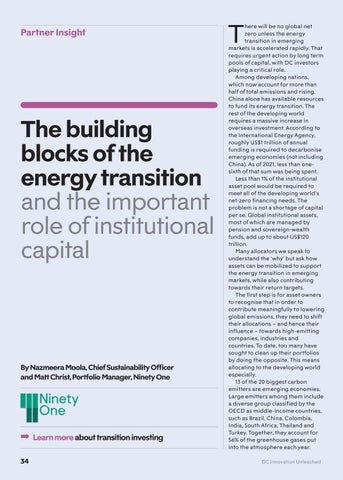Partner Insight
The building blocks of the energy transition and the important role of institutional capital
By Nazmeera Moola, Chief Sustainability Officer and Matt Christ, Portfolio Manager, Ninety One
➡ Learn more about transition investing 34
T
here will be no global net zero unless the energy transition in emerging markets is accelerated rapidly. That requires urgent action by long term pools of capital, with DC investors playing a critical role. Among developing nations, which now account for more than half of total emissions and rising, China alone has available resources to fund its energy transition. The rest of the developing world requires a massive increase in overseas investment. According to the International Energy Agency, roughly US$1 trillion of annual funding is required to decarbonise emerging economies (not including China). As of 2021, less than onesixth of that sum was being spent. Less than 1% of the institutional asset pool would be required to meet all of the developing world’s net-zero financing needs. The problem is not a shortage of capital per se. Global institutional assets, most of which are managed by pension and sovereign-wealth funds, add up to about US$120 trillion. Many allocators we speak to understand the ‘why’ but ask how assets can be mobilized to support the energy transition in emerging markets, while also contributing towards their return targets. The first step is for asset owners to recognise that in order to contribute meaningfully to lowering global emissions, they need to shift their allocations – and hence their influence – towards high-emitting companies, industries and countries. To date, too many have sought to clean up their portfolios by doing the opposite. This means allocating to the developing world especially. 13 of the 20 biggest carbon emitters are emerging economies. Large emitters among them include a diverse group classified by the OECD as middle-income countries, such as Brazil, China, Colombia, India, South Africa, Thailand and Turkey. Together, they account for 56% of the greenhouse gases put into the atmosphere each year. DC Innovation Unleashed








